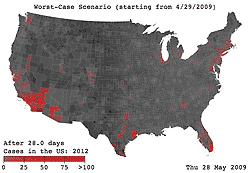
Photo Credit: Dr. F. A. Murphy, Centers for Disease Control and Prevention
Description: This colorized negative-stained transmission electron micrograph (TEM) depicts the ultrastructural details of a number of influenza virus particles, or "virions". A member of the taxonomic family Orthomyxoviridae, the influenza virus is a single-stranded RNA organism.
Current U.S. Case Count
Human cases of AH1N1 virus infection have been identified in these states.
Investigations are ongoing to determine the source of the infection and whether additional people have been infected with AH1N1 viruses.
CDC is working very closely with officials in states where human cases of AH1N1 have been identified, as well as with health officials in Mexico, Canada and the World Health Organization. This includes deploying staff domestically and internationally to provide guidance and technical support. CDC has activated its Emergency Operations Center to coordinate this investigation.
Laboratory testing has found the AH1N1 virus susceptible to the prescription antiviral drugs oseltamivir and zanamivir and has issued interim guidance for the use of these drugs to treat and prevent infection with AH1N1 viruses. CDC also has prepared interim guidance on how to care for people who are sick and interim guidance on the use of face masks in a community setting where spread of this swine flu virus has been detected. This is a rapidly evolving situation and CDC will provide new information as it becomes available.
There are everyday actions people can take to stay healthy.
- Cover your nose and mouth with a tissue when you cough or sneeze. Throw the tissue in the trash after you use it.
- Wash your hands often with soap and water, especially after you cough or sneeze. Alcohol-based hands cleaners are also effective.
- Avoid touching your eyes, nose or mouth. Germs spread that way.
Try to avoid close contact with sick people.
- Influenza is thought to spread mainly person-to-person through coughing or sneezing of infected people.
- If you get sick, CDC recommends that you stay home from work or school and limit contact with others to keep from infecting them.
Topics on this page:
General Information
Swine Flu and You
What is swine flu? Are there human infections with swine flu in the U.S.? &
Swine Flu Video Podcast
Dr. Joe Bresee, with the CDC Influenza Division, describes swine flu - its signs and symptoms, how it's transmitted, medicines to treat it, steps people can take to protect themselves from it, and what people should do if they become ill.
Key Facts about AH1N1 (Swine Flu)
How does swine flu spread? Can people catch swine flu from eating pork? &
AH1N1 in Pigs and People
Brochure
Summary Guidance
CDC has provided the following interim guidance for this investigation.
Residents of States with AH1N1 Cases
CDC has identified human cases of AH1N1 virus infection in people in the U.S. CDC is working with local and state health agencies to investigate these cases. We have determined that this virus is contagious and is spreading from human to human. However, at this time, we have not determined how easily the virus spreads between people. As with any infectious disease, we are recommending precautionary measures for people residing in these areas.
- Cover your nose and mouth with a tissue when you cough or sneeze. Throw the tissue in the trash after you use it.
- Wash your hands often with soap and water, especially after you cough or sneeze. Alcohol-based hands cleaners are also effective.
- Try to avoid close contact with sick people.
- If you get sick, CDC recommends that you stay home from work or school and limit contact with others to keep from infecting them.
- Avoid touching your eyes, nose or mouth. Germs spread that way.
There is no vaccine available at this time, so it is important for people living in these areas to take steps to prevent spreading the virus to others. If people are ill, they should attempt to stay at home and limit contact with others. Healthy residents living in these areas should take everyday preventive actions.
People who live in these areas who develop an illness with fever and respiratory symptoms, such as cough and runny nose, and possibly other symptoms, such as body aches, nausea, or vomiting or diarrhea, should contact their health care provider. Their health care provider will determine whether influenza testing is needed.
Related Links
WHO - Influenza-Like Illness in the United States and Mexico


